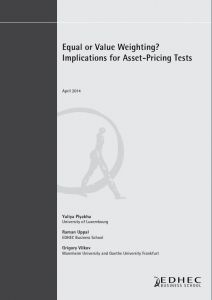

Equal or Value Weighting? Implications for Asset-Pricing Tests
Does the choice of weighting scheme used to form test portfolios influence inferences drawn from empirical tests of asset pricing? To answer this question we first show that, with monthly rebalancing, an equal-weighted portfolio outperforms a value-weighted portfolio in terms of total mean return, four-factor alpha, and Sharpe ratio. We then explain that this outperformance is partly because the equal-weighted portfolio has higher exposure to systematic risk factors; but, a considerable part (42%) of the outperformance comes from the difference in alphas, which is a consequence of the rebalancing to maintain constant weights in the equal-weighted portfolio. Finally, we demonstrate that the inferences drawn from tests of asset-pricing models are substantially different depending on whether one uses equal- or value-weighted test portfolios.
Author(s):
Summary:
Does the choice of weighting scheme used to form test portfolios influence inferences drawn from empirical tests of asset pricing? To answer this question we first show that, with monthly rebalancing, an equal-weighted portfolio outperforms a value-weighted portfolio in terms of total mean return, four-factor alpha, and Sharpe ratio. We then explain that this outperformance is partly because the equal-weighted portfolio has higher exposure to systematic risk factors; but, a considerable part (42%) of the outperformance comes from the difference in alphas, which is a consequence of the rebalancing to maintain constant weights in the equal-weighted portfolio. Finally, we demonstrate that the inferences drawn from tests of asset-pricing models are substantially different depending on whether one uses equal- or value-weighted test portfolios.
Register to download PDF
Register/Log in| Type : | Working paper |
|---|---|
| Date : | 04/07/2014 |
| Keywords : |
Asset Pricing |

